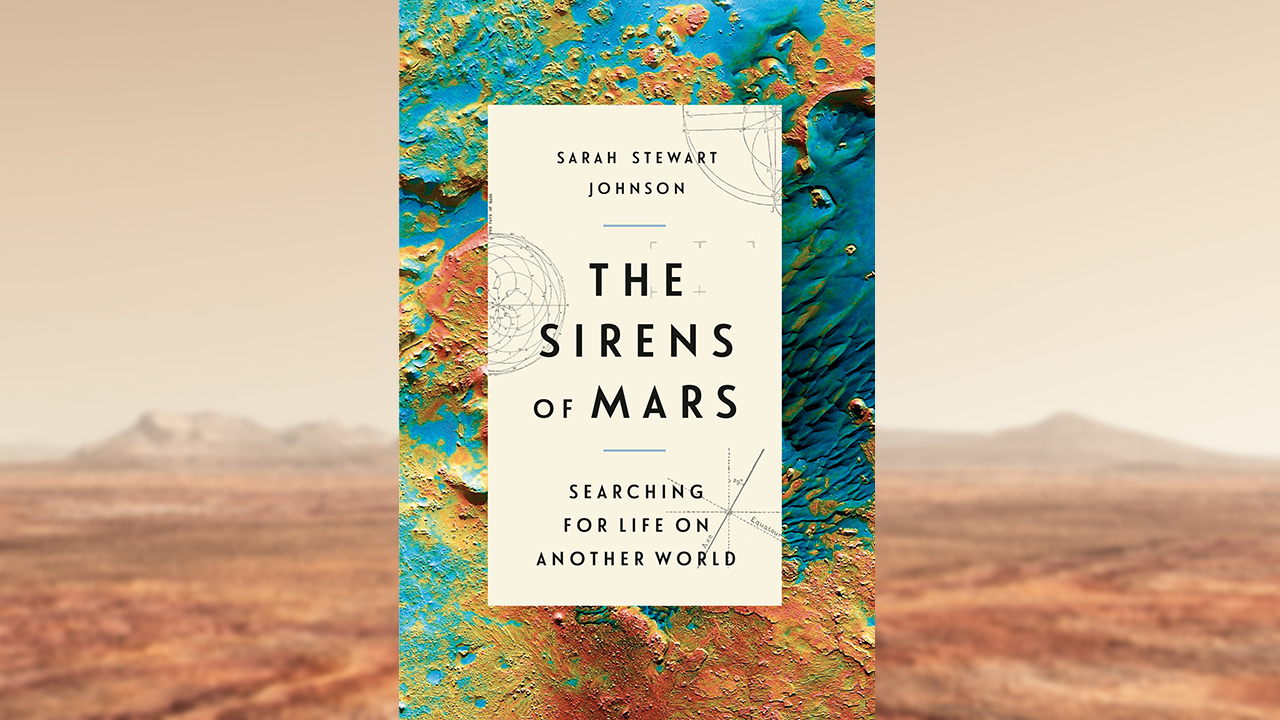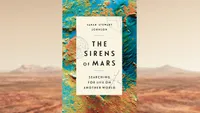Book excerpt: 'The Sirens of Mars' on early views of the Red Planet

For centuries, humans have looked to the bright, reddish dot moving across our skies and wondered about its secrets.
Now, Mars is a world we feel like we know, even as its mysteries continue to puzzle scientists. But our history with the Red Planet has been poignant, complicated, hopeful and depressing, as planetary scientist Sarah Stewart Johnson explores in her new book, "The Sirens of Mars: Searching for Life on Another World" (Crown, 2020), which traces the search for life on Earth's neighbor.
In this excerpt from the first chapter, Johnson and her father look at Mars through a telescope, and NASA scientists analyze the first image ever from a planetary flyby, in 1965 when Mariner 4 captured humanity's best yet photograph of the Martian surface.
Related: 'The Sirens of Mars' tells of the search for life on Mars
The Sirens of Mars: Searching for Life on Another World
Crown, 2020 | $28.99 on Amazon
Join planetary scientist Sarah Stewart Johnson on a journey to the Red Planet in the real-life search for life on other worlds.
Excerpt from Chapter 1: Into the Silent Sea
Not long after I graduated from college, I convinced my father to come with me on a trip into thin desert air. He got on an airplane with me, something he'd only done a few times in his life, and we flew from Kentucky to Atlanta and then on to Tucson. We rented a car and drove deep into Arizona's Old West country, to a hill over a kilometer above the San Pedro River Valley. There was a little hotel, which closed several years ago, at the Vega-Bray Observatory.
We checked in, then went to examine the telescopes. There was a forty-six-centimeter reflector beneath a roll-off roof, a couple of thirty-centimeter Meades, and a half-meter Maksutov-Cassegrain. We zeroed in on a twenty-centimeter Newtonian scope optimized for planetary viewing, which we moved to the observing deck just after dark. There was no tracking system or computer on it, just a sighting mechanism, which was all we needed. My father knew everything about the night sky.
He had spent a good deal of my childhood in the backyard with sky maps from Astronomy magazine tucked beneath his elbow. As much as my father would have loved training for a career in geology or astronomy, he'd needed a job to make ends meet, and he'd found one working with the state health department, just like my grandfather had. I'd seen the night sky many times through his oversized binoculars, which invariably wobbled in my hands, even though he always tried to hold them steady for me.
Breaking space news, the latest updates on rocket launches, skywatching events and more!
By this point in my life, I'd been to places like Lick Observatory and Mount Wilson Observatory. I'd spent my summers interning at NASA, and I'd visited the giant domes. I'd seen the data that state-of-the-art telescopes could collect flickering on computer screens. But there was something different about seeing the sky through a medium-range telescope at Vega-Bray.

That night in the desert, I sensed for the first time what Galileo and other early astronomers must have felt, something that's been lost in the age of computers. Planetary science used to be an amateur enterprise. Before the dawn of the Space Age, every single practitioner had a direct relationship with the night sky. They were awake when others slept, alone with their science and their thoughts, enveloped by the vast physical world. To point the barrel of a telescope at a tiny dot in the sky and then see it as a world, that dot, that very one right there! Of all the thousand pinpricks of lights, that one is different. That one's threaded by rings. That one has tiny moons, suspended like marbles. That little alabaster hat is a polar cap. That one is a world.
Standing there in the cold night air with my father, the telescope at my eye, I felt connected not only to Mars but to Galileo, to Huygens, to Newton, to Herschel. You can't see something like that and not yearn to see it better. As I squinted, making adjustment after adjustment to the dials of the telescope, all I wanted was to fly up to it. Or at least keep the image still. I cursed the atmosphere that wouldn't allow it — the same sky that keeps us alive, brings us rains, and softens our shadows. Even the rarefied air of Arizona tremored and swirled and maddeningly made heavens flicker away. Caught in the grasp of longing and frustration, I could understand why, by the twentieth century, we had to leave our own planet behind.
…
With the gaps in the strips, the 200-by-200-pixel square frame was elongated into a rectangle, but soon, the edge of the planet was clear. Mariner 4 had taken the first close-up picture of Mars.
Even though the image was half planet, half blackness of space, it was still hailed around the world. The largest-circulation French daily printed the first of the final images, once it was rendered by the computer, across five columns of its front page. it's marvelous, read the huge banner of The Evening News of London. As soon as the picture was placed into the hands of Pope Paul VI, he wrote across it, "vidimus etadmirati sumus" — "we saw and we gazed in wonder."
Related: Best space and sci-fi books for 2020
The camera had fog in it and some of the scan lines failed, causing streaks across the frame. "The resolution was awful," recalls JPL engineer John Casani. "You really couldn't see much." But the images would presumably get better as Mariner 4 came closer and closer to the planet, imaging it as the sun struck the landscape more obliquely, picking up more contrast.
Among the streaks in the first two images, one dark area appeared to be real. It was twenty kilometers wide, shaped somewhat like a W. With the arrival of the third image, other possible features were identified, including a smaller smudge, just three kilometers across. Low hills perhaps? The first three images were released to the press for a quick look. As for interpreting the images, the center director urged patience. He reminded the public that the team's collective human strength was reaching its limits.
Leighton began utilizing some electronic tricks to improve the quality, like erasing the clearly aberrant lines that arose from faulty scanning. But when he got to frame seven, he stopped in his tracks, struggling to believe what he saw. He called Jack James, the mission director, and the then project manager, Dan Schneiderman, into a small, secure room and showed them the tiny Polaroid of the video scope. It wasn't at all what they had expected. They stared at the image in quiet disappointment. Eventually, Schneiderman uttered what they all knew to be true: "Jack, you and I have a twenty-minute jump on the rest of the lab to go out and look for new jobs."
Related: The search for life on Mars (a photo timeline)
Scarcely anyone had been prepared for what frame seven revealed, much less what they saw in the next dozen images. "My God, it's the moon," thought Norm Haynes, one of the systems engineers. There were craters in the image, all perfectly preserved, which meant the planet was in bleak stasis. The crust hadn't been swallowed by the churn of plate tectonics, but, more important, the surface hadn't been worn down by the ebb and flow of water. Preserved craters meant there had been no resurfacing, no aqueous weathering of any kind resembling that of the Earth. As with the moon, it appeared there had never been any significant quantity of liquid water on the surface — no rainfall, no oceans, no streams, no ponds.
Excerpted from "The Sirens of Mars" by Sarah Stewart Johnson Copyright © 2020 by Sarah Stewart Johnson. Excerpted by permission of Crown, an imprint of Random House, a division of Penguin Random House LLC. All rights reserved. No part of this excerpt may be reproduced or reprinted without permission in writing from the publisher.
You can buy "The Sirens of Mars" on Amazon or Bookshop.org.
Follow us on Twitter @Spacedotcom and on Facebook.

Sarah Stewart Johnson's research is driven by the underlying goal of understanding the presence and preservation of biosignatures within planetary environments. Her lab is also involved in the implementation of planetary exploration, analyzing data from current spacecraft as well as devising new techniques for future missions. A former Rhodes Scholar and White House Fellow, she received her Ph.D. from MIT and has worked on NASA’s Spirit, Opportunity, and Curiosity Rovers. She is also a visiting scientist with the Planetary Environments Lab at NASA’s Goddard Space Flight Center. Her recent book, The Sirens of Mars, was a New York Times Editor's Choice and selected as one of the New York Times 100 Notable Books of 2020.

